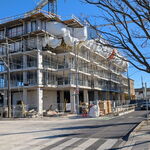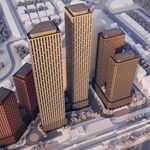dowlingm
Senior Member
If Brampton really wanted to ensure it didn’t come back, putting new sewer/stormwater infra under the alignment might be a more firm way to say “stop dreaming, it’s over”
Not necessarily. A portion of the BCR ROW has a major water trunkline. Many rail rights-of-way are protected by utility easements.If Brampton really wanted to ensure it didn’t come back, putting new sewer/stormwater infra under the alignment might be a more firm way to say “stop dreaming, it’s over”
In today's day and age, once the tracks are ripped up, they never come back. I am not aware of any railways that were ripped up and then brought back.So long as they don't build any structures over top the land where the track used to be, then the rail can always return.
In today's day and age, once the tracks are ripped up, they never come back. I am not aware of any railways that were ripped up and then brought back.
In today's day and age, once the tracks are ripped up, they never come back. I am not aware of any railways that were ripped up and then brought back.
Occasionally as transit lines (Los Angeles’ E/Expo Line is an example), but not as general traffic railways. The one that might return is the Lackawanna Cutoff in New Jersey if the NYC-Scranton train gets built, but that’s only a proposal.
IF it happens.......HFR/HSR will reinstate a chunk of railway between Havelock and Smiths Falls; though a bunch of it will likely be realigned.
I've been thinking about this lately and I don't think it's a bad thing. Redeveloping old rail corridors is a good way to maximize value of land usage and improve the wellbeing of communities. I don't think anyone would look at downtown Toronto today and say they want the rail yards back.The Parks Department has told me they aren't even remotely considering the possibility of preserving rail capacity along the corridor
"Has made" is a bit premature.Has anyone mentioned that The City of Brampton has made a recreation park section for the Orangeville Brampton Rail Trail?
Brampton-Orangeville Rail Trail (BORT)
www.brampton.ca
I've been thinking about this lately and I don't think it's a bad thing. Redeveloping old rail corridors is a good way to maximize value of land usage and improve the wellbeing of communities. I don't think anyone would look at downtown Toronto today and say they want the rail yards back.
When it comes down to it, rail exists to support high volume transport corridors between the largest cities.
Anything less than that and the high fixed costs just make it a brainless proposition.
Local and branch line traffic are much better handled by trucks and busses.
In the end it was reality that killed the OBRY.
The best and most economical practice in rail freight is transloading and containers.
If you want to run a Stadler FLIRT on a rural branch line, first ask why a bus wouldn't suffice.
This type of service which was envisioned on the OBRY, BCRY, Vancouver Island, and Cambridge to Guelph is not a good value use of money and would provide objectively worse service on travel times and frequency in most cases.
The county of Simcoe were rather foolish in stating in their transport master plan that they would preserve the BCRY corridor for such a dream that will never come, rather than taking Brampton's approach of actually getting the most value out of the corridor they paid for.
Local and branch line traffic are much better handled by trucks and busses.
Indeed. Although shrunken, the network of branch lines in the prairies, operated by both Class 1s and shortlines, exist to to gather a single commodity class. Transloading of some bulk commodities, such as lumber and liquids, often adds costs and, in some cases, safety-based complexities.Often true, not always true.
I don't disagree, BUT, if we were to go this route:To me there are three sections of the old OBRY: Mississauga to downtown Brampton, downtown Brampton to Old School Rd, & north of Old School Rd. The first and last sections may never generate enough demand to justify a rail based mobility system but the second (downtown Brampton north to Old School Rd is the focus of significant development and either the Region or Metrolinx should be making plans to use the railway alignment as a fully-separated transit corridor. That could be rail-based (always my personal preference) but there may be a business case that a separated Zum trunk corridor would be more flexible and reduce travel times for more people.
There will soon be an expansion of employment in Downtown Brampton with Rogers main office, the Innovation Centre and post-secondary education opening and the City of Brampton has ambitions for it to act as the commercial & entertainment hub for the area, and this would facilitate access from these new areas of Peel.
View attachment 587352
Red dots are Brampton and Mt Pleasant GO Stations.
View attachment 587371
Map is from the Peel Region Official Plan schedule "Green Belt Plan Area Land Use Designations - Schedule B-5"
I don't think it would be all that parallel to the Hurontario LRT. I think this proposal would offer a better connection between the Kitchener and Milton line.I don't disagree, BUT, if we were to go this route:
I used to support this position as well, but it probably makes more sense to extend Hurontario LRT north on Main, and in that case, a EMU/DMU line on OBRY is dead as it's just too close.
- You'd need to restore the ROW. Definitely physically - there's been track removal - but maybe also legally, I'm not entirely sure.
- You need an OMSF, and it'd be hard to get one built between Queen and Old School.
- As always, where's the funding?
This thing makes more sense as a branch of Milton GO, when that thing gets the RER treatment in 30 years or whenever; I don't believe that Milton demand will be as high as mainline Mississauga demand. However, I can't see that being politically viable when it's been a trail for that long.




